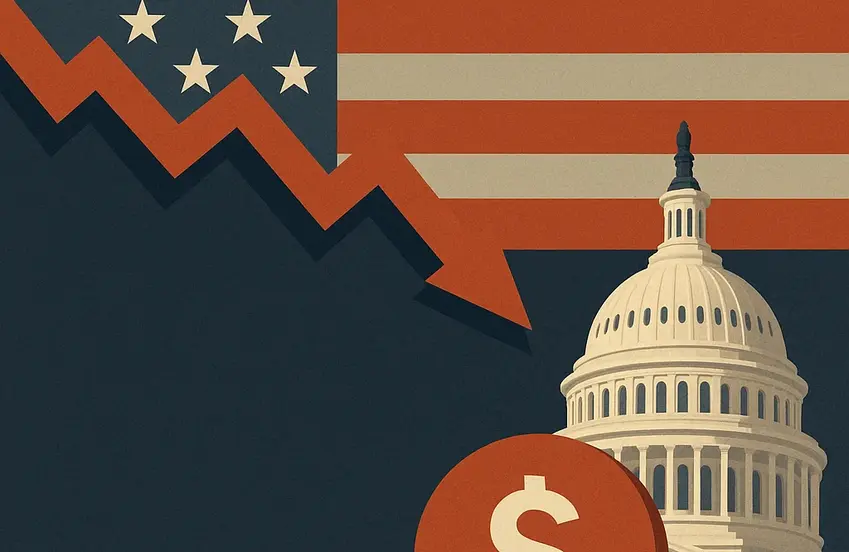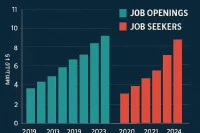Introduction: America’s Fiscal Emergency
The United States faces an unprecedented fiscal challenge that threatens the very foundation of its economic stability. With federal debt now equal to the size of the entire economy and projected to grow exponentially, experts are sounding alarm bells about what many describe as an “alarming national debt crisis.” As former Treasury Secretary Robert Rubin puts it, the U.S. fiscal situation resembles “a 350-pound, two-pack-a-day smoker on the ICU table.” This comprehensive analysis explores the potential consequences of America’s unsustainable debt trajectory and what it means for investors, citizens, and global stability if immediate action isn’t taken.
The Magnitude of America’s Deficit Problem
Historical Context: How We Got Here
For much of American history, the federal government attempted to maintain balanced budgets, with deficits primarily occurring during wars or economic downturns. This fiscal discipline dramatically shifted toward the end of the 20th century. While the Clinton administration briefly achieved a budget surplus in the late 1990s—the first since 1969—subsequent administrations have overseen ballooning deficits.
According to economic experts, today’s massive debt accumulation stems from roughly equal parts:
- Tax cuts that reduced federal revenue
- Significant increases in government spending
- Emergency responses to crises like the 2008 financial collapse and COVID-19 pandemic
Current Deficit Metrics: The Numbers Are Staggering
The fiscal outlook has deteriorated to unprecedented levels:
- The deficit-to-GDP ratio currently stands at 6.7%—the highest outside of a war or recession
- Interest payments on the national debt are expected to reach nearly $1 trillion this year
- By 2025, interest costs will exceed spending on Medicare, Medicaid, and national defense
- Interest payments now consume 18% of total tax revenue, up from less than 10% in 2022
As Kent Smetters from the Wharton Budget Model warns, “Fiscal policy is not sustainable. The economy essentially blows up. There is so much debt under current law that fixed income markets, bond markets will collapse.”
Market Consequences of Runaway Deficits
The Threat of Bond Vigilantes
When investors lose confidence in a government’s fiscal responsibility, they demand higher interest rates to compensate for perceived risk. These “bond vigilantes,” a term coined by economist Ed Yardeni in 1983, can force fiscal discipline through market pressure.
“The bond vigilantes are more powerful than ever,” Yardeni notes, “and the question is, are they going to use that power… and push bond yields up to levels that cause a recession in order to bring inflation down?”
The UK Warning: A Preview of What Could Happen
The United Kingdom experienced a mini-debt crisis in 2022 when then-Prime Minister Liz Truss announced £45 billion in unfunded tax cuts. The market response was immediate and severe:
- The British pound collapsed
- Investors rapidly sold UK government bonds
- Pension funds were forced into distress selling
- The Bank of England had to intervene to stabilize markets
- The government quickly reversed course, but Truss resigned after just six weeks
While the U.S. enjoys unique advantages as the issuer of the world’s reserve currency, this cautionary tale demonstrates how quickly market confidence can evaporate when fiscal policy appears unsustainable.
Institutional Investors Are Taking Notice
PIMCO, the world’s largest bond manager overseeing $2 trillion in assets, has already begun reducing its exposure to long-dated U.S. debt due to “deteriorating deficit dynamics.” While PIMCO’s chief investment officer emphasizes that the U.S. remains the global reserve currency with strong institutions, he notes that other countries’ sovereign debt “looks at least as good as the rate levels in the United States, and is running much more prudent overall fiscal policy.”
This shift in institutional sentiment is reflected in the “term premium”—the extra yield investors demand for holding longer-term bonds—which recently hit its highest level in more than a decade.
Economic Ripple Effects of the Debt Crisis
Crowding Out Essential Government Functions
As interest payments consume an ever-larger share of the federal budget, they “squeeze out” other priorities:
- Defense spending (now less than interest payments for the first time)
- Infrastructure investment
- Research and development
- Social programs
- Education funding
This fiscal constraint limits the government’s ability to invest in productivity-enhancing initiatives that could generate future economic growth.
Limited Crisis Response Capacity
The growing debt burden severely restricts the government’s ability to respond to future emergencies. As Ray Dalio, founder of Bridgewater Associates, observes: “2008 financial crisis, COVID, we actually used debt to get our way out… What happens now when debt itself is the problem? You can’t use debt to get out of the debt problem.”
With geopolitical tensions rising and climate-related disasters increasing in frequency, this diminished fiscal capacity represents a significant vulnerability.
Intergenerational Inequity
The current fiscal path imposes substantial burdens on younger and future generations. Economic content creator Kyla Scanlon highlights that young Americans face a double burden: “Not only are they not going to have access to those services [Social Security, Medicare, Medicaid], but they’re also going to have to pay for those who did before them.”
The traditional justification that future generations would have higher living standards has become increasingly questionable. As Scanlon notes, “It’s a very risky moment where it’s quite clear for younger generations: they don’t know exactly what they’re inheriting.”
Looking for guidance on navigating your financial future in this uncertain environment? Check out our personal finance resources for strategies to protect your wealth.
International Implications of America’s Debt Crisis
National Security Vulnerabilities
Former Chairman of the Joint Chiefs of Staff Admiral Michael Mullen made headlines in 2010 when he identified the national debt—not a weapon system or adversary nation—as the greatest threat to U.S. national security. This assessment has only become more relevant as interest payments now exceed defense spending.
Historian Niall Ferguson warns that this fiscal constraint creates strategic vulnerability: “That is a really major problem for a superpower that is in a game of chicken with another superpower.”
Foreign Holdings of U.S. Debt
International investors hold nearly $9 trillion in U.S. Treasury securities, with Japan and China among the largest foreign creditors:
- Japan holds more than $1 trillion in U.S. debt
- China’s holdings are estimated at approximately $800 billion (though the actual figure may be higher)
While some analysts have raised concerns that foreign creditors could use their Treasury holdings as leverage in geopolitical disputes, most experts consider a deliberate “dumping” of Treasuries unlikely, as it would impose significant financial losses on the selling country.
Global Reserve Currency Status at Risk
The U.S. dollar’s position as the world’s reserve currency provides America with what former French President Valéry Giscard d’Estaing called an “exorbitant privilege”—the ability to borrow in its own currency at favorable rates. However, persistent fiscal irresponsibility could eventually undermine this status.
As PIMCO’s CIO notes, while the U.S. continues to attract global capital due to its dynamic economy and strong institutions, investors are increasingly looking to “diversify into other areas of the world” with more prudent fiscal policies.
Potential Solutions and Political Challenges
The Hard Choices Ahead
Addressing the deficit will require difficult decisions about government revenue and spending:
- Tax increases to boost federal income
- Spending reductions across government programs
- Reforms to entitlement programs like Social Security and Medicare
- Investments in productivity-enhancing initiatives to boost economic growth
Treasury Secretary Scott Bessent has indicated the administration’s goal is to grow the economy faster than the debt, with a long-term objective of cutting the current 6.7% deficit-to-GDP ratio in half.
Political Polarization as the Core Challenge
Admiral Mullen now identifies political division—not the debt itself—as America’s greatest national security threat: “The debt is one, education is another, the healthcare issue, the Social Security issue. That is going to take bipartisan support. It’s going to take leaders from both sides of the political aisle to agree.”
Unfortunately, as political polarization intensifies, the prospects for the necessary compromise appear increasingly remote. Both parties have embraced “all of the easy things,” as one expert notes—cutting taxes and increasing spending—while avoiding the difficult choices required for fiscal sustainability.
Need help finding opportunities in today’s challenging economic environment? Search thousands of jobs on WhatJobs to discover positions in resilient sectors.
Hiring? Post Jobs with WhatJobs to Find Financially Savvy Talent
In times of economic uncertainty, you need employees who understand fiscal responsibility. WhatJobs connects you with professionals who can strengthen your financial position and help your business thrive.
Post a Job NowFAQ: Understanding America’s National Debt Crisis
How does the current national debt crisis differ from previous periods of high government debt?
The current national debt crisis is unprecedented in peacetime America. While the U.S. has experienced higher debt-to-GDP ratios during World War II, those debts were accumulated for a finite emergency and were followed by decades of strong economic growth and fiscal discipline. Today’s debt crisis stems from structural deficits during normal economic times, with interest payments consuming an ever-larger portion of the federal budget. Unlike previous eras, demographic trends (aging population) and rising healthcare costs create additional pressure that wasn’t present in earlier debt reduction periods.
What immediate warning signs would indicate that the national debt crisis is reaching a tipping point?
Several market indicators would signal that the national debt crisis is approaching a critical threshold: rapidly rising interest rates on Treasury bonds, significant widening of the term premium, credit rating downgrades of U.S. government debt, reduced demand at Treasury auctions, accelerating inflation as the Federal Reserve potentially monetizes debt, and a weakening dollar against major currencies. Financial experts particularly watch the term premium—the extra yield investors demand for holding longer-term bonds—which has recently reached its highest level in over a decade, suggesting growing investor concern about long-term fiscal stability.
How might the national debt crisis affect average Americans’ personal finances?
The national debt crisis could impact Americans’ personal finances through multiple channels. Rising interest rates would increase borrowing costs for mortgages, auto loans, credit cards, and student loans. Higher inflation might erode purchasing power if the government resorts to monetizing debt. Reduced government services and benefits could result from budget constraints, particularly affecting Social Security and Medicare recipients. Tax increases would likely be necessary to address the deficit, reducing take-home pay. Finally, slower economic growth due to “crowding out” of private investment could limit job opportunities and wage growth across the economy.
Could the U.S. actually default on its debt, and what would be the consequences of such a default?
While a technical default is possible—as nearly occurred during debt ceiling standoffs—a true inability to pay is extremely unlikely because the U.S. can create its own currency. As former Federal Reserve Chairman Alan Greenspan noted, “The United States can pay any debt it has because we can always print money to do that.” However, this solution carries its own severe consequences: potential rapid inflation, loss of the dollar’s reserve currency status, and a collapse in market confidence. The more likely scenario is what economists call a “soft default” through inflation, where the government effectively pays back its debts with devalued dollars, imposing significant costs on bondholders and the broader economy.
Conclusion: A Crossroads for America’s Economic Future
The United States stands at a critical juncture in its fiscal history. The alarming national debt crisis threatens not just abstract economic indicators but the concrete well-being of American citizens, the nation’s global standing, and its capacity to meet future challenges.
Ray Dalio estimates “more than a 50% chance that in three years, give or take a year or two, that we will experience a trauma if we don’t deal with this well.” Kent Smetters’ Wharton model suggests a potential bond market collapse within 20 years if current trends continue.
These aren’t distant theoretical concerns but imminent threats requiring immediate attention. As Admiral Mullen emphasizes, addressing this challenge will demand bipartisan cooperation and a willingness to make difficult choices—qualities currently in short supply in Washington.
The path to fiscal sustainability won’t be easy or painless. It will require honest conversations about taxation, spending priorities, and the proper role of government. But the alternative—continuing down the current unsustainable path—risks economic instability, diminished national security, and a compromised future for generations to come.
The time for action is now, before the invisible fence is hit and the full consequences of fiscal irresponsibility become impossible to avoid.




